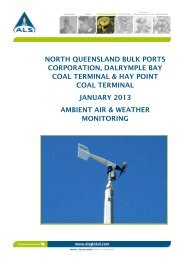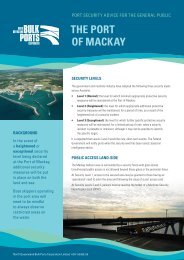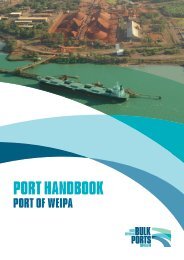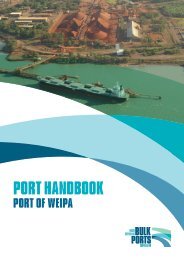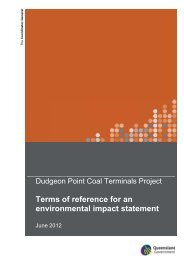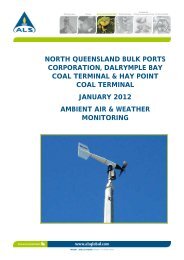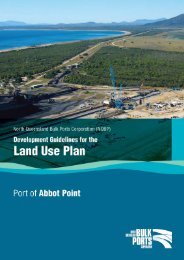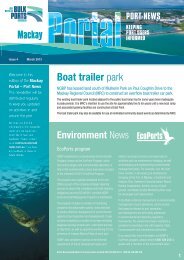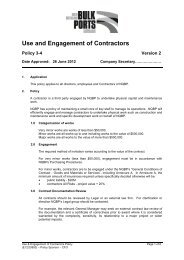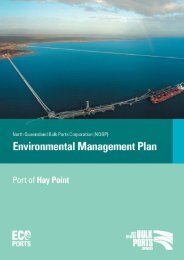Recruitment and Selection - Close
Recruitment and Selection - Close
Recruitment and Selection - Close
Create successful ePaper yourself
Turn your PDF publications into a flip-book with our unique Google optimized e-Paper software.
<strong>Recruitment</strong> <strong>and</strong> <strong>Selection</strong>Policy 6-6 Version 2Date Approved: 22 February 2011Company Secretary…………………1. ApplicationThis policy applies to all Directors, employees <strong>and</strong> Contractors of NQBP.2. PolicyThis policy is in place to ensure that NQBP is adequately <strong>and</strong> effectively staffed at alltimes <strong>and</strong> to ensure that all internal <strong>and</strong> external c<strong>and</strong>idates are assessed equitably <strong>and</strong>ethically in accordance with laws governing non-discriminatory selection.The process commences by determining a need to recruit <strong>and</strong> obtaining approval to fillthe defined vacancy. The process is completed when a suitable c<strong>and</strong>idate is appointed<strong>and</strong> successfully orientated to the Corporation.The recruitment of employees sourced both internally <strong>and</strong> externally, is the responsibilityof the manager in that area of the business (Recruiting Manager [RM]). This policy is tobe read in conjunction with the <strong>Recruitment</strong> <strong>and</strong> <strong>Selection</strong> Procedure.3. Merit-based <strong>Selection</strong>It is NQBP’s practice to hire or promote the best-qualified c<strong>and</strong>idate to fill vacantpositions. All vacancies will be filled by c<strong>and</strong>idates who most closely meet the selectioncriteria.Recruiting Managers will not breach discrimination laws in the consideration of c<strong>and</strong>idatesfor any position. The adherence to the selection criteria in the selection process willconstitute evidence of NQBP’s adherence to fair employment practices. Therefore, therecruitment process is to be followed at all times.Accountability is achieved by recruitment <strong>and</strong> selection processes <strong>and</strong> associateddocumentation being open <strong>and</strong> subject to appropriate scrutiny <strong>and</strong> review having regardto the confidentiality of the c<strong>and</strong>idates.4. Approval to RecruitWritten approval to recruit or replace employees, including temps <strong>and</strong> contractors must beobtained from the Manager HR/IR <strong>and</strong> CEO before the process can begin.Engagement of staff can only be made after the confirmation of approval to recruit.<strong>Recruitment</strong> <strong>and</strong> <strong>Selection</strong> Page 1 of 4(E11/05471) – Policy Sponsor - CFO
5. Position DescriptionPosition descriptions are used to link work to the achievement of the organisationalobjectives <strong>and</strong> the monitoring of employee performance. It is imperative that positiondescriptions accurately define the position <strong>and</strong> its requirements at the outset <strong>and</strong> over theevolution of that position within the organisation.Position descriptions should be reviewed regularly. A review of the position descriptionshould occur when there are changes in responsibility, tasks or when the positionbecomes vacant.It is essential that the requirements of the position are thoroughly understood <strong>and</strong> that allpositions are clearly defined within the organisation structure <strong>and</strong> communicated tojobholders. All position responsibilities should be documented in writing, using thest<strong>and</strong>ard position description template <strong>and</strong> approved by the General Manager, ManagerHR/IR, CEO <strong>and</strong> if necessary, the DCEO before it can become effective.Position descriptions will form the basis of the selection criteria for vacant positions.6. Management ResponsibilityIt is the responsibility of the RM to ensure that job requirements are specified, that there isappropriate sourcing, <strong>and</strong> potential c<strong>and</strong>idates are reviewed <strong>and</strong> interviewed.The final selection of the c<strong>and</strong>idate (internal or external) is the responsibility <strong>and</strong> decisionof appropriate selection panel.7. AdvertisingAll employees must be afforded equal opportunities to secure promotion <strong>and</strong>advancement in their employment. As a matter of courtesy, employees who apply forinternal vacancies should notify their Manager of their application. Vacancies will beadvertised internally, externally or concurrently.External advertising will normally be advertised on the internet <strong>and</strong> on independent onlinejob sites (such as Seek.com.au). Job vacancies can also be advertised via a localpublication in order to gain coverage in the relevant area, depending on the location <strong>and</strong>needs of the position.8. <strong>Selection</strong> CommitteeA selection committee will be formed for every vacancy <strong>and</strong> will comprise of threemembers. There will be one independent person participating in the committee with atleast one male <strong>and</strong> one female. An independent person is someone from humanresources, a different department/section or an external party. If it is not feasible for threepeople to be on the selection committee, HR must be made aware of the situation <strong>and</strong>agree to the composition of the committee.9. InterviewsTo ensure Fair Employment Practices are maintained <strong>and</strong> supported, a structuredinterview process should be used. The interview should be based around the selectioncriteria <strong>and</strong> competency/performance st<strong>and</strong>ards for the position.All recruiting Managers should familiarise themselves with legislative <strong>and</strong> organisationalrequirements pertaining to fair recruitment practices, including conducting an interview,documenting interviews <strong>and</strong> selection decisions. Interview Forms <strong>and</strong> assistance withinterviews can be obtained from Human Resources.<strong>Recruitment</strong> <strong>and</strong> <strong>Selection</strong> Page 2 of 4(E11/05471) – Policy Sponsor - CFO
The process of induction <strong>and</strong> assimilation of a new employee begins at the time ofinterview. It is at this time that potential employees are evaluating the Corporation.10. Pre-employment AssessmentsDepending on the position, c<strong>and</strong>idates may be required to undergo a pre-employmenthealth/physical assessment prior to any formal offer of employment.Since ethical <strong>and</strong> legal requirements exist in this area, the Manager HR/IR may beconsulted prior to any pre-employment health/physical assessments being completed.HR can also provide advice regarding a suitable medical service for this purpose.C<strong>and</strong>idates may be required to undergo other assessments prior to employment e.g.skills, aptitude, competency or behavioural/psychological testing. The Manager HR/IRshould be consulted for all testing that is to be included in the selection process.11. Reference CheckingSatisfactory references from the c<strong>and</strong>idate’s previous employers must be obtained prior toextending an employment offer. This applies to both internal <strong>and</strong> external c<strong>and</strong>idates.Former employees of NQBP seeking re-employment must provide references fromsubsequent employers.Referees are not to be contacted unless the express permission of the c<strong>and</strong>idate isobtained <strong>and</strong> at all times confidentiality must be maintained.12. Legal Entitlement to WorkTo prevent the employment of employees who are not legally entitled to work in Australia,recruiting Managers are to request <strong>and</strong> sight evidence of citizenship, residency or workpermits or be provided with a guarantee from the recruitment agency (where utilised).13. <strong>Selection</strong> DecisionThe selection recommendation is made by the selection panel <strong>and</strong> submitted to the CEOfor a final decision. If the CEO is not satisfied with the recommendation of the selectionpanel prior to making a final decision, the CEO in the first instance should consult with theselection panel. If the CEO’s view is still contrary to the panel’s recommendation thematter is to be internally reviewed by an independent senior executive (ie who has notbeen involved in the selection process).The internal reviewer shall provide the CEO with a written opinion on the matter, followingthe receipt of which the CEO will make a final decision.<strong>Selection</strong> decisions that are contrary to the selection recommendation must bedocumented in a manner that explains the rationale for the decision <strong>and</strong> the decisionmaking process.14. ProbationDetails of probation periods are addressed in individual contracts, letters of offer <strong>and</strong> theNQBP Enterprise Agreement (s).<strong>Recruitment</strong> <strong>and</strong> <strong>Selection</strong> Page 3 of 4(E11/05471) – Policy Sponsor - CFO
15. Complaints <strong>and</strong> AppealsA number of appeal <strong>and</strong> complaint processes are available to applicants, depending onthe nature of their concerns. RM’s should contact human resources to discuss anycomplaints or appeals. Depending on the nature of the complaint, employees will haveaccess to the following appeal processes:• Complaint processes contained in anti discrimination legislation;• Grievance policy <strong>and</strong> procedures; <strong>and</strong>• Grievance processes contained in collective agreements.16. Policy Review DateThis policy should be reviewed by 30 June 2012.17. DefinitionsNQBP: means North Queensl<strong>and</strong> Bulk Ports Corporation Limited ACN 136 880 218 <strong>and</strong>its related bodies corporate including Ports Corporation of Queensl<strong>and</strong> Limited ACN 126302 994 (PCQ) <strong>and</strong> Mackay Ports Limited ACN 131 965 707 (MPL).Contractors: means Contractors or consultants engaged by NQBP under a personalservices consultancy agreement or other similar arrangements.Recruiting Manager: (RM) means the NQBP manager responsible for the hiring of thenew employee into his/her section.<strong>Recruitment</strong> <strong>and</strong> <strong>Selection</strong> Page 4 of 4(E11/05471) – Policy Sponsor - CFO




